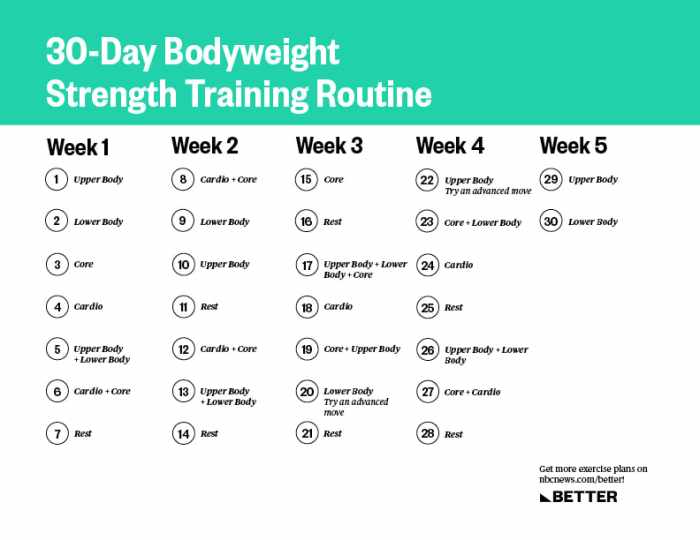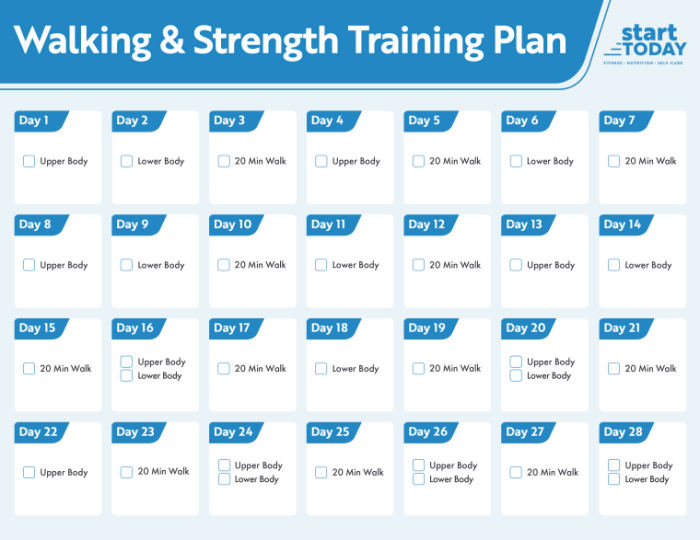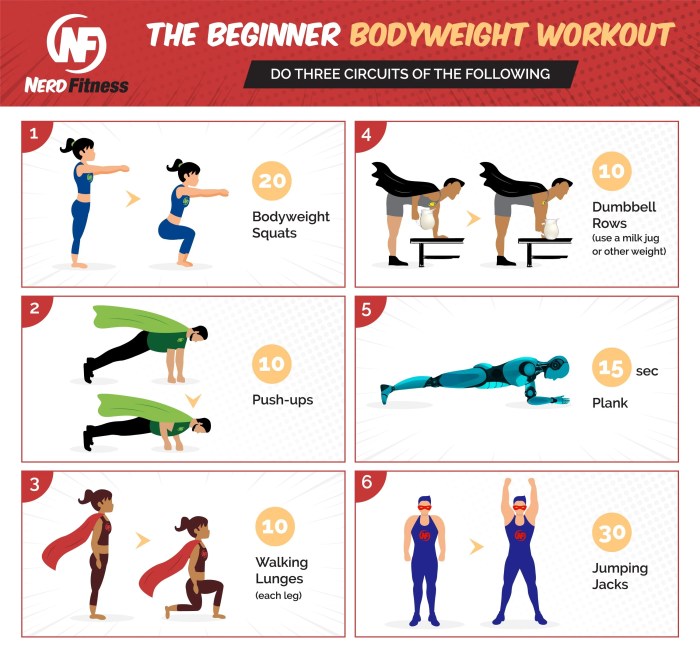Embark on a transformative journey with our basic weight training plan, meticulously designed for beginners. Discover the secrets to unlocking your fitness potential and achieving your physique goals.
This plan will guide you through every aspect of weight training, from exercise selection to nutrition and recovery. Whether you’re new to the gym or looking to reignite your fitness flame, this plan will empower you to make lasting changes.
Set and Repetition Guidelines

Determining the number of sets and repetitions for each exercise is crucial for effective weight training. Understanding the difference between strength and hypertrophy-focused training is key.
Strength Training
- Goal:Increase maximal strength
- Sets:3-5 sets
- Repetitions:6-12 repetitions
- Rest:2-3 minutes between sets
- Weight:80-95% of 1RM (one-repetition maximum)
Hypertrophy Training
- Goal:Increase muscle size
- Sets:8-12 sets
- Repetitions:8-15 repetitions
- Rest:1-2 minutes between sets
- Weight:60-80% of 1RM
Training Frequency

Training frequency refers to how often you engage in weight training workouts per week. For beginners, it’s essential to start with a frequency that allows for adequate rest and recovery while promoting gradual progress.
Optimal Training Frequency for Beginners
Aim for 2-3 weight training sessions per week, with at least one day of rest in between each session. This frequency provides sufficient time for your muscles to recover and rebuild, while also allowing for consistent stimulation and adaptation.
Benefits of Rest and Recovery
Rest is a crucial component of any training program. It allows your body to:
- Repair damaged muscle tissue
- Replenish energy stores
- Reduce muscle soreness
- Prevent injuries
- Improve overall performance
By incorporating adequate rest days into your schedule, you can maximize the benefits of your weight training workouts and avoid overtraining.
– Emphasize the importance of proper exercise technique.: Basic Weight Training Plan

Proper exercise technique is crucial for maximizing the effectiveness and safety of your weight training program. It ensures that you target the correct muscles, reduce the risk of injury, and improve your overall form and posture.
To perform exercises with proper technique, focus on the following key principles:
- Control the movement:Avoid using momentum or swinging your body to complete the exercise. Instead, focus on controlling the movement throughout its entire range of motion.
- Engage the correct muscles:Pay attention to which muscles you are trying to work and actively engage them during the exercise. Avoid using other muscles to compensate for weakness.
- Maintain proper alignment:Keep your body in a neutral position, with your spine straight and your core engaged. Avoid arching your back or rounding your shoulders.
- Breathe properly:Inhale as you lower the weight and exhale as you lift it. This helps to stabilize your body and prevent dizziness.
Step-by-Step Instructions for Basic Exercises, Basic weight training plan
To help you master proper technique, here are step-by-step instructions for some basic weight training exercises:
| Exercise | Step-by-Step Instructions | Tips for Proper Form | Common Mistakes to Avoid |
|---|---|---|---|
| Barbell Bench Press |
|
|
|
| Barbell Squat |
|
|
|
| Dumbbell Row |
|
|
|
Video Demonstrations:
- Barbell Bench Press: https://www.youtube.com/watch?v=A_nqe-K_zYM
- Barbell Squat: https://www.youtube.com/watch?v=6vSN_s7pdBA
- Dumbbell Row: https://www.youtube.com/watch?v=J65sZ6y7vBQ
Last Point

As you progress through this basic weight training plan, remember to prioritize proper form, listen to your body, and enjoy the process. With consistency and dedication, you’ll witness remarkable transformations in your strength, physique, and overall well-being.
Commonly Asked Questions
How often should I train per week?
Beginners should aim for 2-3 weight training sessions per week, allowing for rest and recovery.
What is the best way to warm up before a workout?
Start with 5-10 minutes of light cardio, such as jogging or cycling, followed by dynamic stretches that target the muscles you’ll be working.
How much weight should I lift?
Choose a weight that challenges you while maintaining good form. If you’re unsure, start with a lighter weight and gradually increase as you get stronger.
What should I eat to support my weight training goals?
Focus on a balanced diet rich in protein, carbohydrates, and healthy fats. Include plenty of fruits, vegetables, and whole grains.
How can I prevent injuries?
Always use proper form, warm up before workouts, and listen to your body. If you experience any pain, stop the exercise and consult with a healthcare professional.
Leave a Reply